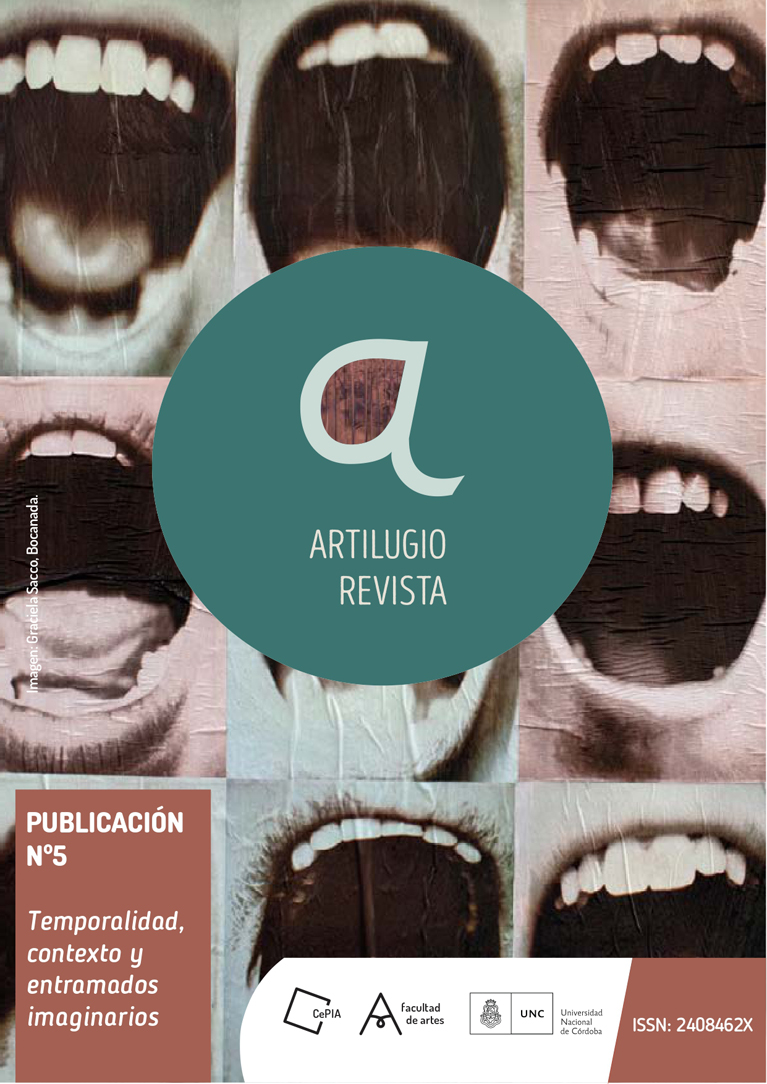Of Guns and Sewing-Machines. On the Minor Nature of Third Cinema in Mexico
DOI:
https://doi.org/10.55443/artilugio.n5.2019.25325Keywords:
Cooperativa de Cine Marginal, Cine Club, mexican filmmaking, Third Cinema, temporalityAbstract
One of the most telling examples of the afterlives of Mexico’s movement of 1968 was the emergence of a significant number of art and film collectives that sought to articulate aesthetics and politics. The Marginal Film Coop (Cooperativa de Cine Marginal, 1971-1975) was the first of this kind of collectives, and probably the most politically committed of them. Created in 1971 as a grouping of young independent filmmakers, students, political activists, film clubbers and critics that had played different roles in the brigades of the 1968 movement, the Coop soon became a national network of production, distribution and exhibition of radical political cinema composed of more than 35 people, with solid relations with workers and unions across the country.
Based on interviews, personal archives of some of its members, film journals and scattered Super 8 materials held at Filmoteca UNAM, my reading of the Coop explores how the “unsustained nature” of Mexican political cinema was part of a political and aesthetic operation of contesting a prevailing metaphor of Latin American’s political cinema, the camera as a weapon, and the temporality associated to it.Downloads
References
Santiago Álvarez, “Arte y Compromiso”, Trincontinental, 7 (1968): 113-115.
Jorge Ayala Blanco, La búsqueda del cine mexicano (1968-1972) (México DF: Posada, 1986).
Paula Barreiro López, “Un Vietnam en el campo de la cultura: objetos promiscuos en el arsenal de la guerrilla”, en Atlántico Frío. Historias transnacionales del arte y la política en los tiempos del telón de acero (Madrid: Brumaria, 2019).
Bertolt Brecht, “On the Formalistic Character of the Theory of Realism”, en Ernst Bloch, Georg Lukacs, Bertolt Brecht, Walter Benjamin y Theodor Adorno, Aesthetics and PoIitics (Londres: Verso, 1980), 70-76.
Julianne Burton, “The Camera as ‘Gun’: Two Decades of Culture and Resistance in Latin America”, Latin American Perspectives, 5, 1 (1978): 49-76. Consultado el 15 de mayo de 2019 en http://www.jstor.org/stable/2633339.
Jonathan Buchsbaum, “One, Two... Third Cinemas”, Third Text, 25, 1 (2011): 13-28. Consultado el 2 de enero de 2019 en http://dx.doi.org/10.1080/09528822.2011.545607.
Ignacio del Valle Ávila, Le “Nouveau cinéma latino-américain”: un projet de d’eveloppement cinématographique sous-continental. Musique, musicologie et arts de la scène (Tolosa: Université Toulouse le Mirail, 2012). Consultado el 8 de junio de 2019 en https://tel.archives-ouvertes.fr/tel-00782109.
Ignacio del Valle Ávila, “Hacia un tercer cine: del manifiesto al palimpsesto”, El ojo que piensa. Revista de cine iberoamericano, 3, 5 (2012). Consultado el 10 de julio de 2019 en http://www.elojoquepiensa.cucsh.udg.mx/index.php/elojoquepiensa/article/view/79/80.
Susana Draper, México 68. Experimentos de la libertad, constelaciones de la democracia (Ciudad de México: Siglo XXI, 2018).
León Ferrari, “El arte de los significados”, en Prosa política (Buenos Aires: Siglo XXI, 2005), 20-27.
Guadalupe Ferrer, La experiencia de la Cooperativa de Cine Marginal en el auge de la lucha obrera de 1971-1973. Documento mecanografiado, borrador de una tesis de licenciatura incompleta, circa 1976. Archivo de Guadalupe Ferrer.
Silvana Flores, Regionalismo e integración cinematográfica: el Nuevo Cine Latinoamericano en su dimensión continental (1960-1970). Tesis doctoral (Facultad de Filosofía y Letras, Universidad de Buenos Aires, 2011). Consultado el 10 de julio de 2019 en http://repositorio.filo.uba.ar/jspui/bitstream/filodigital/1671/1/uba_ffyl_t_2010_865453.pdf
Teshome Gabriel, Third Cinema in the Third World. The Aesthetics of Liberation (Ann Arbor: Umi Research Press, 1982).
Alberto Híjar, Hacia un tercer cine (México DF: Universidad Nacional Autónoma de México, 1972).
Julio Le Parc, “La guerrilla cultural” (s/d., 1968). Consultado el 12 de julio de 2019 en http://www.julioleparc.org/guérilla-culturelle.html.
Ana Longoni, Vanguardia y revolución (Buenos Aires: Ariel, 2014).
Ana Longoni y Mariano Mestman, Del Di Tella a Tucumán Arde. Vanguardia artística y política en el 68 argentino (Buenos Aires: Eudeba, 2008).
Fernando Martín Peña y Carlos Vallina, editores, El cine quema. Raymundo Gleyzer (Buenos Aires: Ediciones de la Flor, 2000).
David D. N. Rodowick, The Crisis of Political Modernism. Criticism and Ideology in Contemporary Film Theory (Berkeley: University of California Press, 1994).
Jorge Sanjinés, “Su testimonio en Mérida”, Cine del tercer mundo, 1 (octubre de 1969): 78-80.
Peter B. Schumann, “Súper 8 en México”, en Kino und Kampf in Lateinamerika. Zur Theorie und Praxis des politischen Kinos (Múnich y Viena: Hanser Verlag, 1976). Traducción mecanografiada al español del capítulo dedicado a la Cooperativa de Cine Marginal, anónima. Archivo de Guadalupe Ferrer.
Fernando Solanas y Jean-Luc Godard, “Godard por Solanas, Solanas por Godard”, Cine del tercer mundo, 1 (octubre de 1969): 48-63.
Fernando Solanas y Octavio Getino, “Hacia un tercer cine. Apuntes y experiencias para el desarrollo de un cine de liberación en el Tercer Mundo”, Cine Club, 1 (octubre de 1970): 27-40.
Ignacio Taibo, Los extraños caminos de un cine para el pueblo. Documento interno mecanografiado de la Cooperativa de Cine Marginal, 1972. Archivo de Guadalupe Ferrer.
Álvaro Vázquez Mantecón, “México: el 68 cinematográfico”, en Mariano Mestman, coordinador, Las rupturas del 68 en el cine de América Latina (Madrid: Akal, 2016), 281-306.
Álvaro Vázquez Mantecón, El cine súper 8 en México 1970-1989 (México DF: Filmoteca UNAM, 2012).
Paul Willemen, “The Third Cinema Question: Notes and Reflections”, Framework, 34 (1986): 4-38.
Downloads
Published
Issue
Section
License
Copyright (c) 2019 Miguel Errazu

This work is licensed under a Creative Commons Attribution-NonCommercial-NoDerivatives 4.0 International License.





































